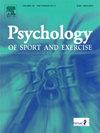Influence of environmental pressure and inhibitory control capacity on anxiety, mental workload and shooting performance in multitasking basketball contexts
IF 3.3
2区 心理学
Q2 HOSPITALITY, LEISURE, SPORT & TOURISM
引用次数: 0
Abstract
Background
Basketball shooting performance is crucial for match outcomes, often influenced by environmental pressure and anxiety. This study investigates how increased task demands and outcome consequences affect anxiety, mental workload, and shooting performance in multitasking basketball contexts. Additionally, it examines the moderating role of inhibitory control (IC) on these effects.
Methods
Thirty-nine youth basketball athletes (26 males and 13 females; age 14.9 ± 1.3 years) participated in two experimental sessions with varying levels of environmental manipulation: Low Environmental Manipulation (LEM) and High Environmental Manipulation (HEM), differing in the cognitive-motor complexity of the task and the consequences associated with performance outcomes. An intrasubject, repeated measures design was used, where participants performed multitasking activities involving dribbling and shooting under different rules and scoring systems. Anxiety, mental workload, and shooting performance were measured, along with participants' baseline IC.
Results
The HEM condition significantly increased anxiety (p < 0.001) and mental workload (p < 0.001) compared to the LEM condition, leading to a notable decrease in shooting performance (p < 0.001). Participants with higher IC exhibited better performance (p = 0.007 for LEM, p = 0.046 for HEM) and lower mental workload. Regression analyses indicated that cognitive-motor performance accuracy (p = 0.016) and mental activity (p = 0.004) were significant predictors of shooting performance and state anxiety (p < 0.001).
Conclusions
Environmental pressure, through increased task demands and outcome consequences, elevates anxiety and mental workload, negatively impacting basketball shooting performance. Higher IC moderates these effects, suggesting that athletes with better inhibitory abilities can maintain performance under pressure. These findings highlight the importance of designing training programs that simulate competitive pressure and develop athletes' cognitive control capacities.
环境压力和抑制控制能力对多任务篮球运动中焦虑、心理负荷和投篮表现的影响
篮球投篮表现对比赛结果至关重要,经常受到环境压力和焦虑的影响。本研究探讨了在多任务篮球情境下,任务需求和结果的增加如何影响焦虑、心理负荷和投篮表现。此外,它检查抑制控制(IC)对这些影响的调节作用。方法39名青少年篮球运动员,男26名,女13名;年龄(14.9±1.3岁)的被试分别参与了低环境操作(LEM)和高环境操作(HEM)两组不同水平环境操作的实验,他们在任务的认知-运动复杂性和与表现结果相关的后果方面存在差异。实验采用了主体内重复测量设计,参与者在不同的规则和计分系统下进行多任务处理,包括运球和射门。测量焦虑、心理负荷和射击表现,以及参与者的基线ic。结果HEM条件显著增加焦虑(p <;0.001)和精神负荷(p <;0.001),导致射孔性能显著下降(p <;0.001)。IC高的参与者表现出更好的绩效(LEM p = 0.007, HEM p = 0.046)和更低的心理负荷。回归分析表明,认知-运动表现准确性(p = 0.016)和心理活动(p = 0.004)是射击表现和状态焦虑的显著预测因子(p <;0.001)。结论环境压力通过增加任务要求和结果后果,增加焦虑和心理负荷,对篮球投篮表现产生负向影响。较高的IC调节了这些影响,这表明具有更好抑制能力的运动员可以在压力下保持表现。这些发现强调了设计模拟竞争压力和发展运动员认知控制能力的训练计划的重要性。
本文章由计算机程序翻译,如有差异,请以英文原文为准。
求助全文
约1分钟内获得全文
求助全文
来源期刊
CiteScore
6.40
自引率
5.90%
发文量
172
审稿时长
69 days
期刊介绍:
Psychology of Sport and Exercise is an international forum for scholarly reports in the psychology of sport and exercise, broadly defined. The journal is open to the use of diverse methodological approaches. Manuscripts that will be considered for publication will present results from high quality empirical research, systematic reviews, meta-analyses, commentaries concerning already published PSE papers or topics of general interest for PSE readers, protocol papers for trials, and reports of professional practice (which will need to demonstrate academic rigour and go beyond mere description). The CONSORT guidelines consort-statement need to be followed for protocol papers for trials; authors should present a flow diagramme and attach with their cover letter the CONSORT checklist. For meta-analysis, the PRISMA prisma-statement guidelines should be followed; authors should present a flow diagramme and attach with their cover letter the PRISMA checklist. For systematic reviews it is recommended that the PRISMA guidelines are followed, although it is not compulsory. Authors interested in submitting replications of published studies need to contact the Editors-in-Chief before they start their replication. We are not interested in manuscripts that aim to test the psychometric properties of an existing scale from English to another language, unless new validation methods are used which address previously unanswered research questions.

 求助内容:
求助内容: 应助结果提醒方式:
应助结果提醒方式:


